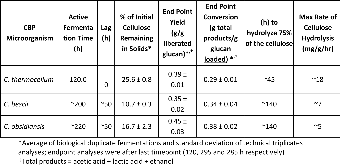Fermentation of dilute acid pretreated Populus by Clostridium thermocellum, Caldicellulosiruptor bescii, and Caldicellulosiruptor obsidiansis
- Oak Ridge National Lab. (ORNL), Oak Ridge, TN (United States); Genomatica Inc., San Diego, CA (United States)
- Oak Ridge National Lab. (ORNL), Oak Ridge, TN (United States)
- Oak Ridge National Lab. (ORNL), Oak Ridge, TN (United States); Univ. of Tennessee, Knoxville, TN (United States)
- Oak Ridge National Lab. (ORNL), Oak Ridge, TN (United States); Dessert Research Institute, Las Vegas, NV (United States)
- Oak Ridge National Lab. (ORNL), Oak Ridge, TN (United States); White Cliff Biosystems, Rockwood, TN (United States)
Consolidated bioprocessing (CBP), which merges enzyme production, biomass hydrolysis, and fermentation into a single step, has the potential to become an efficient and economic strategy for the bioconversion of lignocellulosic feedstocks to transportation fuels or chemicals. In this study, we evaluated Clostridium thermocellum, Caldicellulosiruptor bescii, and Caldicellulosiruptor obsidiansis, three , thermophilic,cellulolytic, mixed-acid fermenting candidate CBP microorganisms, for their fermentation capabilities using dilute acid pretreated Populus as a model biomass feedstock. Under pH controlled, anaerobic fermentation conditions, each candidate successfully digested a minimum of 75% of the cellulose from dilute acid pretreated Populus, as indicated by an increase in planktonic cells and end-product metabolites and a concurrent decrease in glucan content. C. thermocellum, which employs a cellulosomal approach to biomass degradation, required 120 hours to achieve 75% cellulose utilization. In contrast, the non-cellulosomal, secreted hydrolytic enzyme system of the Caldicellulosiruptor sp. required 300 hours to achieve similar results. End-point fermentation conversions for C. thermocellum, C. bescii, and C. obsidiansis were determined to be 0.29, 0.34, and 0.38 grams of total metabolites per gram of loaded glucan, respectively. This data provide a starting point for future strain engineering efforts that can serve to improve the biomass fermentation capabilities of these three promising candidate CBP platforms.
- Research Organization:
- Oak Ridge National Laboratory (ORNL), Oak Ridge, TN (United States)
- Sponsoring Organization:
- USDOE Office of Science (SC)
- Grant/Contract Number:
- AC05-00OR22725
- OSTI ID:
- 1221721
- Journal Information:
- BioEnergy Research, Vol. 8, Issue 3; Conference: San Jose, California United States, 8-13 June 2014; ISSN 1939-1234
- Publisher:
- SpringerCopyright Statement
- Country of Publication:
- United States
- Language:
- English
Web of Science
Cellulosic ethanol production via consolidated bioprocessing by a novel thermophilic anaerobic bacterium isolated from a Himalayan hot spring
|
journal | March 2017 |
Similar Records
evaluation of the bioconversion of genetically modified switchgrass using simultaneous saccharification and fermentation ans a consolidated bioprocessing approach
Use of Label-Free Quantitative Proteomics To Distinguish the Secreted Cellulolytic Systems of Caldicellulosiruptor bescii and Caldicellulosiruptor obsidiansis
